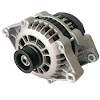Spill Gates
The part of the dam which discharges the flood water to the
down steam side is called “Spillways”.
The spillway does not start discharging till the water
reaches a predetermined level called the full Reservoir level (FRL). The highest
level upto which the water allowed to rise in the reservoir even during high
floods is called “Maximum water level (MWL)”. The difference between MWL and
FRL is called the flood lift. The spillways provides discharge of surplus water
from storage reservoir in to the down steam side of the dam and it will acts a
safety valve for the dam.
Types of spill ways: Depending upon the location of the site
and prevailing circumstances the spillways are mainly classified in to
following typings, namly.
- a.
Over
flow spillway (ogee spillway)
- b.
Chute
spillway.
- c.
Shaft
spillway
- d.
Siphon
spillway.
(a) Over Flow spillway
(Oge spillway): Over
flow type spill way have a control device, called a gate and which is placed on
the top of the crest.
For an ungated over flow spill way the crest level is equal
to full reservoir level (FRL) and is as show in fig a). In case of gated over
flow spill way the crest level is equal to the maximum reservoir level which is
equal to the level of FRL and flood lift (hight of the gate) and is show in fig
Features : the over flow type of spillway is
very simple in construction, low cost and is suitable for concrete dams.
(b) Chute (or) Trough spillway: In this type of spillways the
discharging water flows in a steel sloped open channel called chute. The channel
is made of reinforced concrete cement slabs and is as shows in fig
Features :
1.
These
type of spillways are suited for earth dams because it is very light.
2.
There
are simple in design and construction.
(c) Shaft spillway : This type of spillways are also
called as morning glory spillways. In this type of spillways the water will
first drops through the vertical shift and then it passes through a horizontal
conduit passing through the dam at the bottom which conveys the water to the down
stream side of the dam and is as show in fig
Shaft spillway features
:
1.
This
type of spillways are suitable for narrow gorges
2.
The
main drawback of this shaft spillway is the hazard of clogging with debries.
3.
Maintenance
cost is more as it require additional protecting debries.
(d) Shaft spillways: This type of spillway works on the
principle of siphonic action. It occupies less space and regulates the
reservoir level with narrow limits and is as show in fig
Features:
i) This
type of spillways are used for smaller capacity and where the space available
is limited
ii) This
type of spillways are suitable for gravity dams.
iii) In
this type the water level can be maintained very closed limits automatically.
2. Classification of
spill gates:
The spill gates are mainly used to discharge
the flood water from reservoir to the dam stream without any damage to the dam.
It stores
The spill gates are mainly of the following types, namely.
(a) Vertical lift gates (flat or sliding gates).
(b) Radial (or) traitor gates.
(c) Rolling gates.
(d) Drum gates.
(a) Vertical lift Gates: The are mainly used for smaller
dams. One of its type Is a stoney gates and is as shown in fig. In this type,
the gates are lifted by means of hosting cables.
(b) Radial (or) Traitor
Gates: These gates
are mainly used as a crest gates in spillways. Figs show the view of the radial
gates.
These gates are made with steel and because of the shape is
cylindrical these gates are called as traitor gates. These gates are operated
from hoists which are mounted on the top of the bridge.
(c) Rolling Gates: Rolling gates consists of
cylindrical drums which span the piers and to which attached facing which act
as water barrier and it is as show in fig
This type of gates will rolls on the track when force is applied
by means of hoisting cables. The operation of the gate is accomplished by
rolling the cylindrical beam on inclined tracks through toothed wheels attached
at the ends.










0 Comments